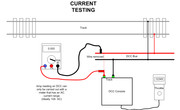HELLO IN MY MESSAGE I CALLED TO READINGS AS VOLTS I MEANT AMPS I AM A NOVICE ONCE AGAIN THANK YOU
Mod Edit. Please DO NOT use all capitals. It is considered to be SHOUTING.
VOLTAGE TO TRACK PART 2
Re: VOLTAGE TO TRACK PART 2
A/C OR D/C AMPS
DRAWING 6 TO 12 AMPS IS MASSIVE ARE YOU SURE YOU ARE READING THE METER CORRECTLY?
I SEE WE ARE STILL SHOUTING
DRAWING 6 TO 12 AMPS IS MASSIVE ARE YOU SURE YOU ARE READING THE METER CORRECTLY?
I SEE WE ARE STILL SHOUTING
Re: VOLTAGE TO TRACK PART 2
I don't like shouting - so won't.
How are you measuring the Amps or Volts?
Most controllers would struggle with that level of Amps, what are you using?
Is it a DC, DCC or AC controller?
How are you measuring the Amps or Volts?
Most controllers would struggle with that level of Amps, what are you using?
Is it a DC, DCC or AC controller?
- Walkingthedog
- Posts: 4972
- Joined: Thu Oct 04, 2018 5:51 pm
- Location: HAZLEMERE, BUCKS.
- Contact:
Re: VOLTAGE TO TRACK PART 2
In his other post he says it is a Prodigy DCC. I didn’t think you could read the DCC voltage with an ordinary multimeter.
Nurse, the screens!
Re: VOLTAGE TO TRACK PART 2
That's the problem with double posting and shouting - I didn't read it all because it is difficult to read ALL CAPITALS, especially long posts.
As I understand it, you can't read DCC voltage etc via a normal meter.
The supplied Gaugemaster power supply is for 3.5amps so readings of 6-12 are obviously false, a fuse (or worse) would have blown.
As I understand it, you can't read DCC voltage etc via a normal meter.
The supplied Gaugemaster power supply is for 3.5amps so readings of 6-12 are obviously false, a fuse (or worse) would have blown.
Re: VOLTAGE TO TRACK PART 2
I really don't think you mean Amps (Amperes)! As you said previously in the first post you are testing at various places around the layout.
Connecting a meter across the rails when on an Amp range will either blow the meters internal fuse (if it has one) or cause the DCC system to shut down!
Note: Many low cost domestic multimeters do not have an AC current range, its normally only found on more expensive meters.
You only measure Amps with the multimeter in series with one feed wire - disconnected one end of the DCC feed wire and connect it to the red lead of the meter. Set meter to AC Amps >5A range and connect the meters black lead to the place where the wire was removed from. Turn on DCC and run loco(s) the reading obtained is the current flowing (Amps) NEVER connect the multimeter across the rails or bus pair of wires when set to Amps range.
To test for DCC voltage, set meter leads into the correct sockets on meter and turn meter dial to AC voltage range of at least 20volts and connect leads across rails or bus pair. Turn on DCC and read voltage. This reading should be constant all around the layout give or take 1/2 a volt (0.5v).

Below...Current (Amp) testing using a meter that has AC Amp capability...

Note: In above drawing the meter lead is moved from the middle socket to the Amps (A) socket. Return the lead to the middle V/R socket as soon as amp reading has finished and turn meters switch to Off or to a volts range. Never leave the lead in the Amps socket.
Re: VOLTAGE TO TRACK PART 2
my apologies for using capitals it wont happen again I have a volt meter but misread the readings checked this pm with correct settings and found readings constant, thanks everyone for advice brian ffound your website going to read to hopefully understand what is required for dcc electrics thank you all lead2327
Who is online
Users browsing this forum: No registered users and 1 guest
